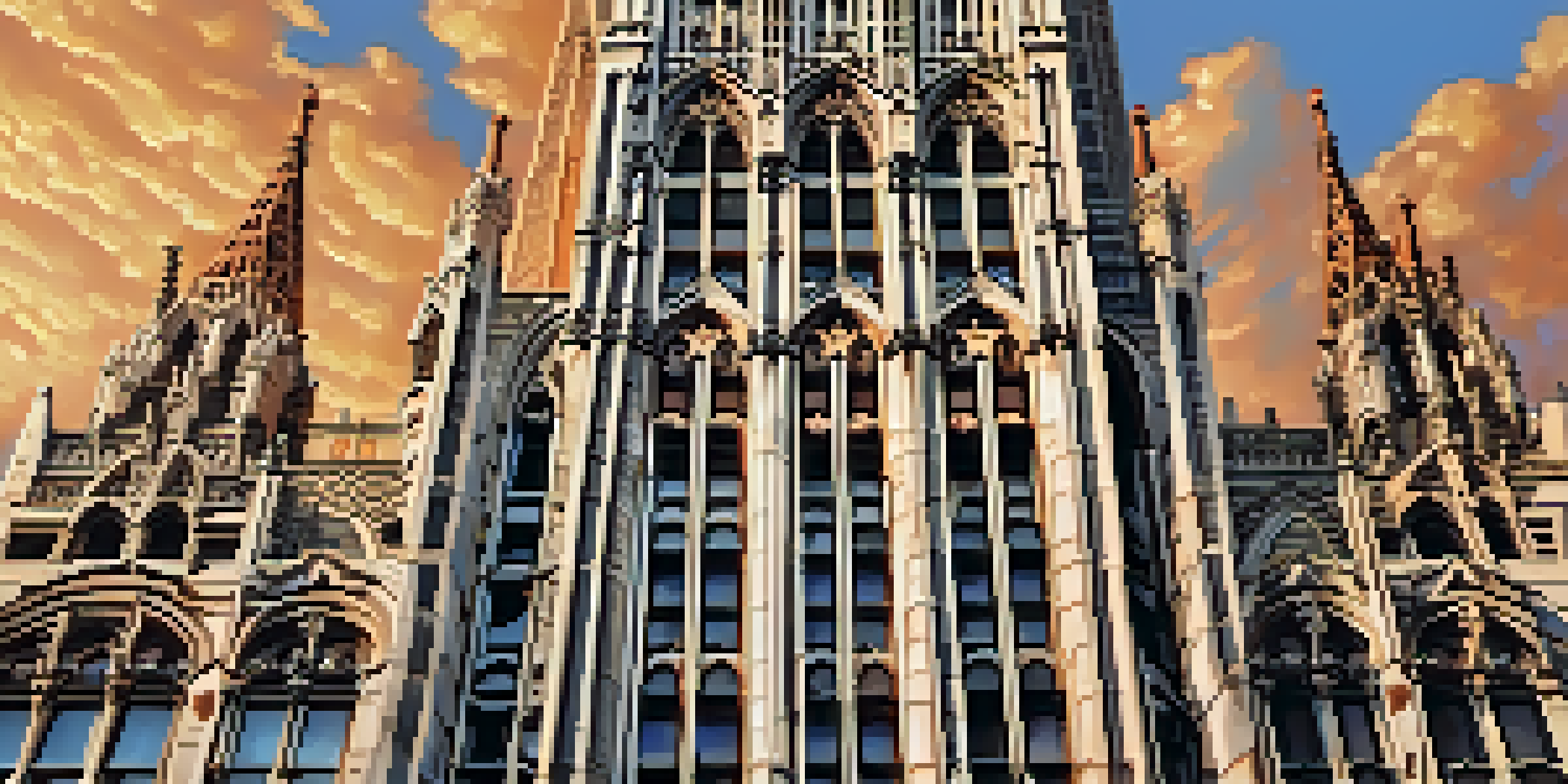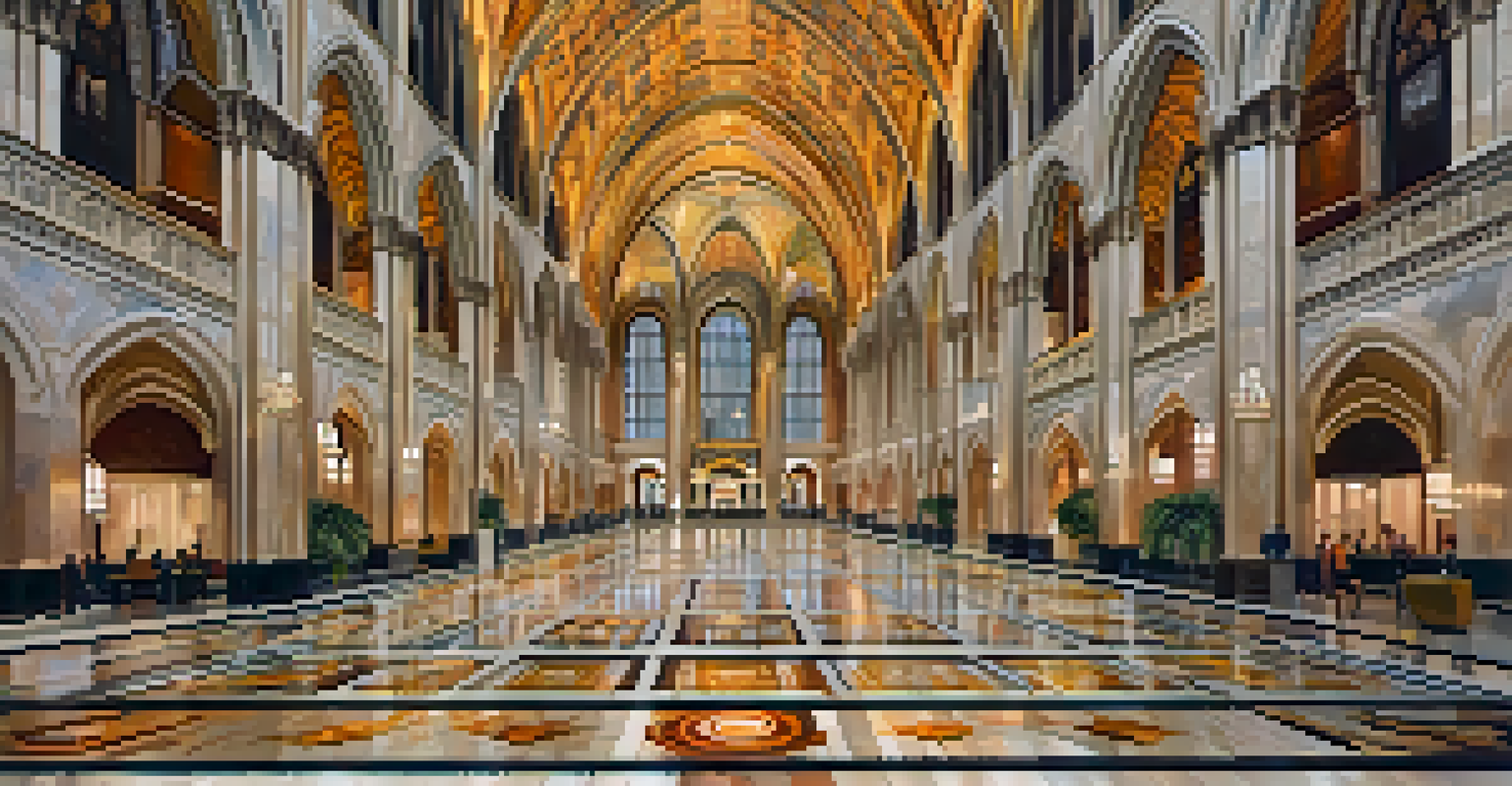Neo-Gothic Architecture: The Beauty of the Woolworth Building

Introduction to Neo-Gothic Architecture
Neo-Gothic architecture, also known as Gothic Revival, emerged in the 19th century, reintroducing the intricate designs and vertical lines reminiscent of medieval Gothic structures. This style is characterized by pointed arches, ribbed vaults, and flying buttresses, which create an ethereal and grand appearance. Many buildings embraced this trend, but few captured its essence like the Woolworth Building in New York City.
Architecture is the art of how to waste space.
The Woolworth Building, completed in 1913, is often regarded as the epitome of Neo-Gothic architecture in the United States. Standing at 792 feet, it was the tallest building in the world at the time, showcasing the ambition and innovation of its era. Its stunning façade and detailed ornamentation invite onlookers to marvel at the craftsmanship from a bygone age.
Understanding Neo-Gothic architecture allows us to appreciate the Woolworth Building not just as a structure, but as a piece of art that embodies a historical narrative. As we explore this iconic building, we will uncover the elements that make it a true masterpiece of architectural design.
The Woolworth Building's Architectural Features
One of the most striking features of the Woolworth Building is its elaborate terracotta façade, which is adorned with intricate carvings and decorative elements. These details reflect the rich artistry and craftsmanship that went into its construction, creating a visual feast for anyone who approaches the building. The use of terracotta was not only aesthetic but also practical, providing a durable surface that withstands the test of time.

The building's soaring spire is another hallmark of Neo-Gothic design, drawing the eye upward and symbolizing aspiration and achievement. This verticality is a key characteristic of the style, evoking a sense of reaching for the heavens. The spire is topped with a lantern, enhancing its prominence in the New York skyline and making it a beacon of architectural prowess.
Woolworth Building: A Neo-Gothic Icon
The Woolworth Building exemplifies Neo-Gothic architecture with its intricate designs and historical significance, making it a landmark in New York City.
Moreover, the interior of the Woolworth Building is just as breathtaking as its exterior. The lobby features stunning mosaics and vaulted ceilings that transport visitors to a different era, showcasing the opulence and grandeur that characterized early 20th-century architecture. Together, these features create a harmonious blend of beauty and function, making the Woolworth Building a true architectural gem.
The Historical Significance of the Woolworth Building
The Woolworth Building was commissioned by Frank W. Woolworth, a retail magnate who dreamed of creating a structure that symbolized his success. It served as the headquarters for the F.W. Woolworth Company, which was known for its popular five-and-dime stores. This connection to commerce adds another layer of significance to the building, as it was a physical representation of American entrepreneurship during the early 20th century.
Good buildings come from good people, and all problems are solved by good design.
Upon its completion, the building became a symbol of the economic prosperity and ambition of the era. Its height and grandeur made it a point of pride for New Yorkers, who saw it as a testament to the city's development and a marker of its skyline. The Woolworth Building stood as a beacon of hope and ambition during a time when the United States was rapidly industrializing and urbanizing.
In addition to its economic significance, the building has also played a role in American cultural history. It has been featured in numerous films, television shows, and literature, solidifying its status as an iconic part of New York City's architectural landscape. Its legacy continues to inspire architects and historians alike, ensuring that its story is told for generations to come.
Visiting the Woolworth Building Today
Today, visitors to the Woolworth Building can appreciate its architectural beauty and historical significance through guided tours. These tours offer insight into the building's design, its construction, and its place in New York City's rich history. As you walk through its grand lobby and admire the intricate details, you can't help but feel a connection to the past.
Many of the tours also explore the surrounding area, highlighting other architectural gems that showcase the diversity of styles found in Manhattan. This context deepens the experience, as visitors can see how the Woolworth Building fits into the larger narrative of the city’s architectural evolution. It's a perfect way to spend an afternoon in the heart of New York.
Challenges in Preservation Efforts
Preserving the Woolworth Building involves overcoming challenges related to funding and maintenance while maintaining its historical authenticity.
For those who appreciate architecture, the Woolworth Building is a must-see. Its combination of Neo-Gothic design and historical significance creates a unique experience that resonates with both locals and tourists. Whether you're a history buff, an architecture enthusiast, or simply looking for a beautiful place to explore, the Woolworth Building offers a captivating glimpse into the past.
The Woolworth Building and Modern Architecture
The Woolworth Building stands as a testament to the enduring influence of Neo-Gothic architecture, especially in the context of modern design. While contemporary buildings often emphasize minimalism and sleek lines, the Woolworth Building reminds us of the beauty found in intricate details and historical references. This juxtaposition highlights the evolution of architectural styles over the past century.
Architects today often draw inspiration from the Woolworth Building when creating new structures, seeking to blend modern functionality with classical beauty. Elements such as pointed arches and decorative motifs can still be seen in some of today's buildings, proving that the principles of Neo-Gothic design continue to resonate. This dialogue between old and new enriches the architectural landscape of cities around the world.
Moreover, the preservation efforts surrounding the Woolworth Building also indicate a growing appreciation for historic architecture in our rapidly changing urban environments. As cities evolve, there is a heightened awareness of the importance of maintaining connections to our architectural heritage. The Woolworth Building serves as an example of how historic structures can coexist with modern developments, creating a tapestry of history and innovation.
Challenges in Preserving the Woolworth Building
Like many historic buildings, the Woolworth Building faces challenges related to preservation and maintenance. The wear and tear from weather, pollution, and time can impact its intricate details and overall integrity. Preservationists work diligently to ensure that necessary repairs are made while maintaining the building's historical authenticity, which can be a delicate balance.
Funding is often a significant hurdle in these preservation efforts. While the building's iconic status attracts interest, securing the necessary resources for maintenance and restoration can be complicated. Grants, donations, and public support are crucial in helping to safeguard the Woolworth Building for future generations to enjoy.
Legacy and Cultural Impact
The Woolworth Building stands as a symbol of ambition and creativity, inspiring admiration and serving as a connection to New York City's rich architectural history.
Despite these challenges, the commitment to preserving the Woolworth Building demonstrates a broader societal appreciation for architectural history. As communities recognize the value of their historic landmarks, more initiatives arise to protect and celebrate these treasures. The ongoing efforts surrounding the Woolworth Building are a testament to the importance of preserving our architectural legacy.
Conclusion: The Legacy of the Woolworth Building
The Woolworth Building is more than just a remarkable example of Neo-Gothic architecture; it is a symbol of ambition, creativity, and resilience. Its intricate design and historical significance have made it a cherished part of New York City's identity. As we reflect on its legacy, we recognize the importance of preserving such structures for future generations to enjoy and learn from.
Visiting the Woolworth Building provides a unique opportunity to connect with the past while appreciating the architectural achievements of today. It serves as a reminder that beauty can be found in the details, and the stories behind these structures enrich our understanding of our shared history. Each visit offers a new perspective and a deeper appreciation for the artistry involved in its creation.

Ultimately, the Woolworth Building stands as a beacon of Neo-Gothic architecture, inspiring both admiration and respect. Its enduring presence in the skyline of New York City encourages us to explore the stories woven into the fabric of our urban environments, reminding us that every building has a tale to tell.